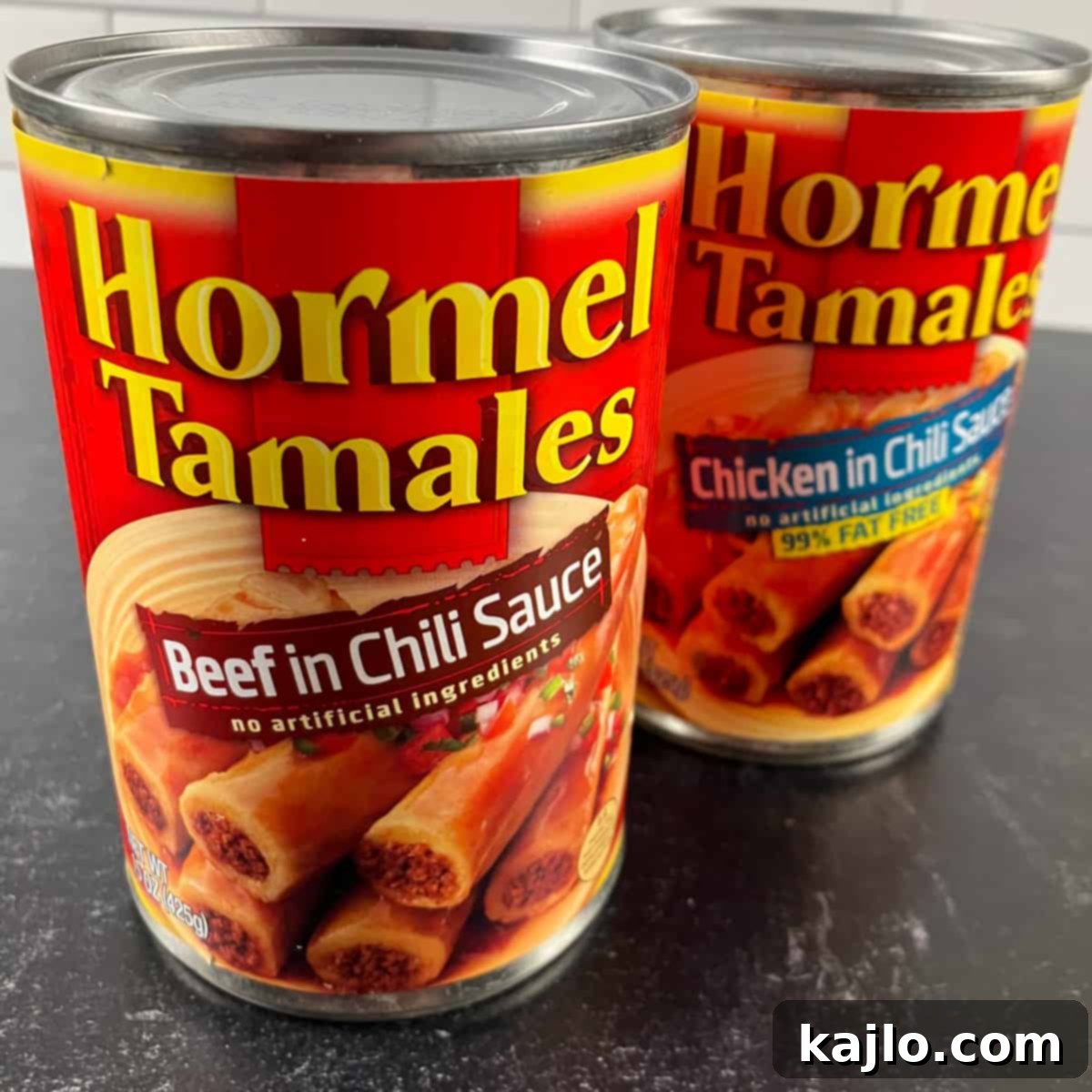Are you wondering, “Do they still make canned tamales?” The answer is a resounding yes! For generations, canned tamales have offered a convenient and comforting meal solution. Whether you’re a long-time fan of Hormel tamales in a can or exploring other reputable brands, this classic Americanized Mexican comfort food remains a fast and easy option for busy weeknights or a quick snack. This comprehensive guide will provide you with valuable insights on how to find the best canned tamales, popular brands, cooking methods, nutritional information, and creative recipes to elevate your canned tamale experience. While the unmatched flavor of homemade Mexican tamales is undeniable, Hormel canned tamales and similar products perfectly satisfy those sudden cravings without requiring hours of kitchen prep.
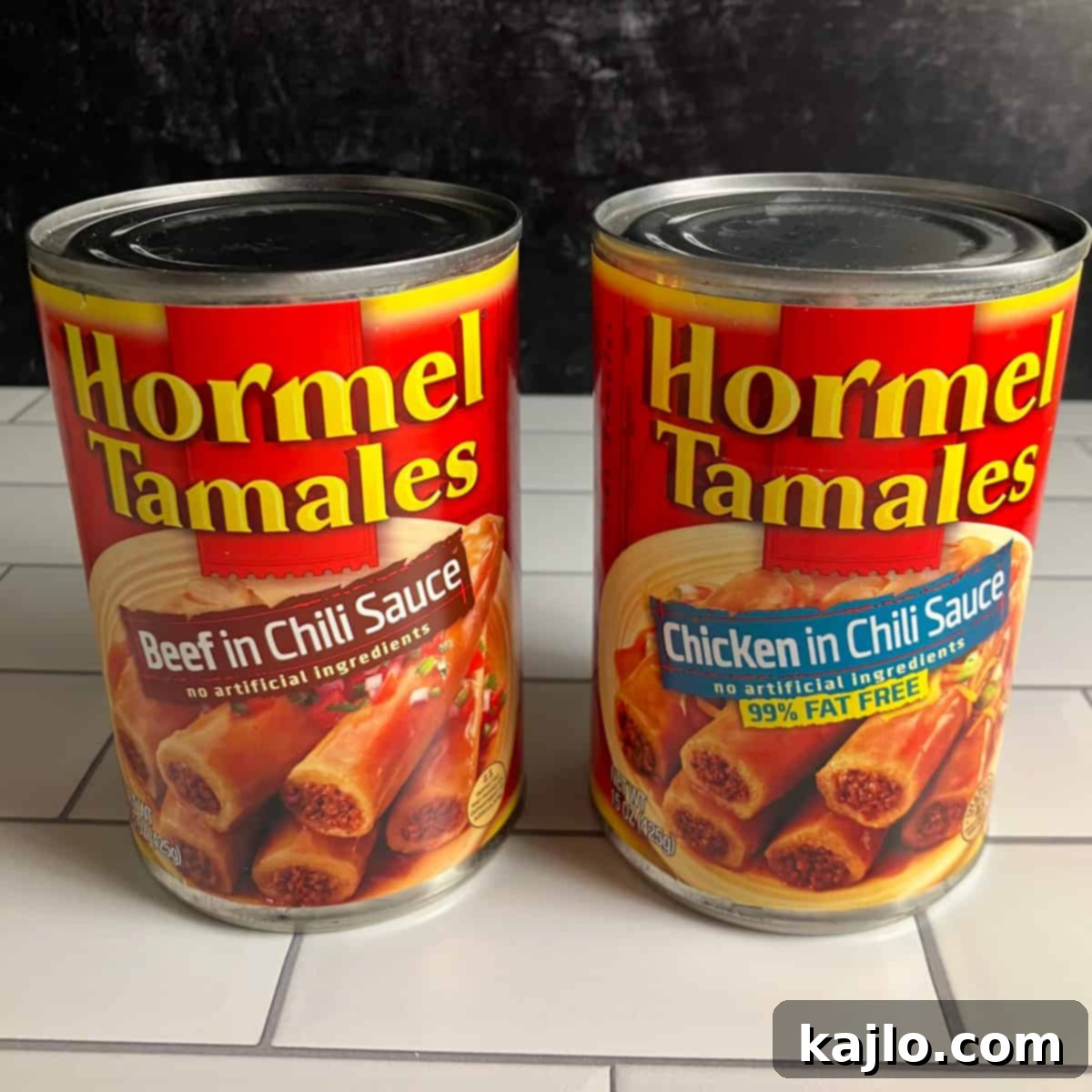
Your Ultimate Guide to Canned Tamales: Brands, Recipes, and More
Tamales hold a special place in Mexican culinary traditions, renowned for their rich flavors and distinctive preparation. Traditionally, tamales consist of a savory or sweet masa dough—made from ground nixtamalized corn and lard—steamed inside a corn husk or banana leaf until firm. These wrappers not only impart flavor but also help the tamales retain their moisture and shape during the cooking process. Authentic tamales come in an astonishing variety, reflecting regional tastes and available ingredients.
In today’s post, we’re diving deep into the world of canned tamales. For those new to tamales, understanding their traditional form helps appreciate the convenience of their canned counterparts. While traditional tamales feature diverse fillings, canned versions typically offer a more limited selection, with beef, chicken, or spicy beef (often labeled “hot tamales”) being the most common choices. It’s worth noting that due to the inclusion of lard and meaty fillings, traditional tamales are generally not suitable for vegan diets. Similarly, their corn-based composition makes them unsuitable for ketogenic or low-carb diets. For individuals following specific dietary restrictions, canned tamales may not be the ideal choice.
Canned vs. Traditional Tamales: A Flavorful Comparison
Canned tamales differ significantly from authentic, scratch-made tamales in several key aspects. For instance, brands like Hormel beef tamales are uniquely packaged. Instead of being wrapped in corn husks, each tamale comes individually encased in a waxy paper, pre-cooked and suspended in a mild chili sauce right in the can. This ready-to-eat format is a major draw for consumers seeking speed and simplicity.
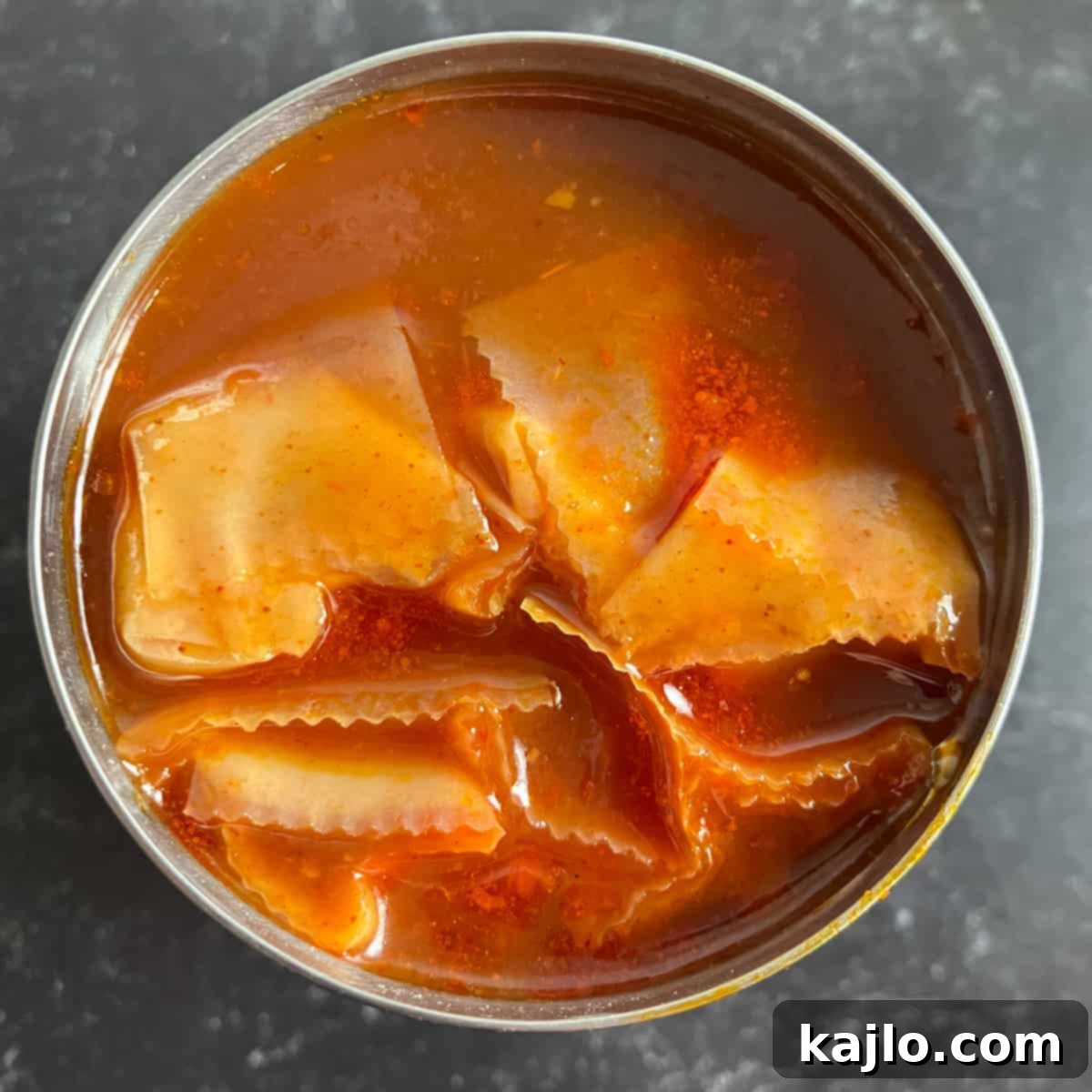
Another notable difference lies in size and quantity. Canned tamales tend to be smaller than their homemade counterparts, and you typically get fewer per container. A standard can of Hormel tamales, for example, usually contains about six small tamales. This makes them a perfect single-serving meal or a quick addition to a larger spread.
The versatility of cooking canned tamales is another significant advantage. They can be heated using various methods, including frying, baking, microwaving, air frying, or cooking on the stovetop. We’ve included detailed cooking directions for Hormel can tamales below, so you’ll always have easy access to preparation instructions, even if your packaging is damaged or lost. These convenient cooking options ensure that a warm, satisfying tamale meal is never far away.
Exploring Popular Canned Tamales Brands
Contrary to some online rumors, Hormel tamales have not been discontinued and remain a staple in many pantries. The market for canned tamales, while not as vast as other canned goods, offers a few reliable brands that have stood the test of time. Here are some of the most popular brands of canned tamales available in the U.S. today:
- Hormel Beef Tamales: A classic choice, known for its hearty beef filling and rich chili sauce.
- Hormel Chicken Tamales: A lighter alternative to the beef version, offering a milder flavor profile.
- La Preferida Canned Tamales (Beef & Pork): Known for a more robust, traditional flavor, often featuring a blend of beef and pork.
- Hormel Hot Tamales (Spicy Beef): For those who enjoy a kick, these tamales come with a spicier beef filling.
- Nalley Beef Tamales: Another well-established brand, offering a consistent and familiar taste.
Currently, these appear to be the primary players in the canned tamale market. You might not find brands like Old El Paso Canned Tamales or Chef Boyardee tamales readily available. If you’re looking for alternatives, frozen tamales from brands like El Monterey are also an option, with some consumers suggesting they offer a taste and texture superior to their canned counterparts.
Finding Your Favorite: The Best Canned Tamales
As a dietitian, my philosophy on the “best” canned tamales is simple: it’s the one you genuinely enjoy. These convenient treats should be savored as an occasional indulgence, rather than a daily dietary staple. If you have a fondness for canned tamales and no specific medical reasons to avoid them, choose the brand that brings back nostalgic memories or simply puts a smile on your face. Taste is highly subjective, and what one person considers delicious, another might find average. Experiment with different brands and fillings to discover your personal favorite.
Decoding Hormel Tamales Ingredients
Curious about what goes into your canned tamales? Let’s break down the ingredients for Hormel’s popular beef tamales:
- Water: The base for the sauce and masa.
- Beef: The primary protein for the filling.
- Tomatoes: Contributes to the flavor and color of the chili sauce.
- Corn Meal: A key component of the tamale dough, providing texture and body.
- Corn Flour: Further refines the texture of the masa.
- 2% or less of: Modified Cornstarch (contains erythorbic acid), Masa Flour, Salt, Chili Powder, Paprika, Spice: These ingredients act as thickeners, flavor enhancers, and preservatives, creating the distinctive taste and consistency of canned tamales.
And here are the ingredients for Hormel chicken tamales, offering a slightly different profile:
- Water: Similar to the beef version, forming the liquid base.
- Tomatoes: For the sauce’s flavor and color.
- Mechanically Separated Chicken: The chicken protein component, processed for a smooth texture.
- Corn Meal: Forms the foundation of the tamale dough.
- Corn Flour: Helps achieve the desired masa consistency.
- Modified Cornstarch (contains erythorbic acid): A thickening agent and preservative.
- 2% or less of: Chili Powder, Masa Flour, Salt, Paprika, Spice: A blend of seasonings and thickeners to create the characteristic flavor.
An interesting point of distinction is that the corn dough in these canned versions primarily uses corn meal and corn flour, rather than solely masa flour, which is central to authentic tamales. This difference contributes to the unique texture and consistency found in canned tamale products.
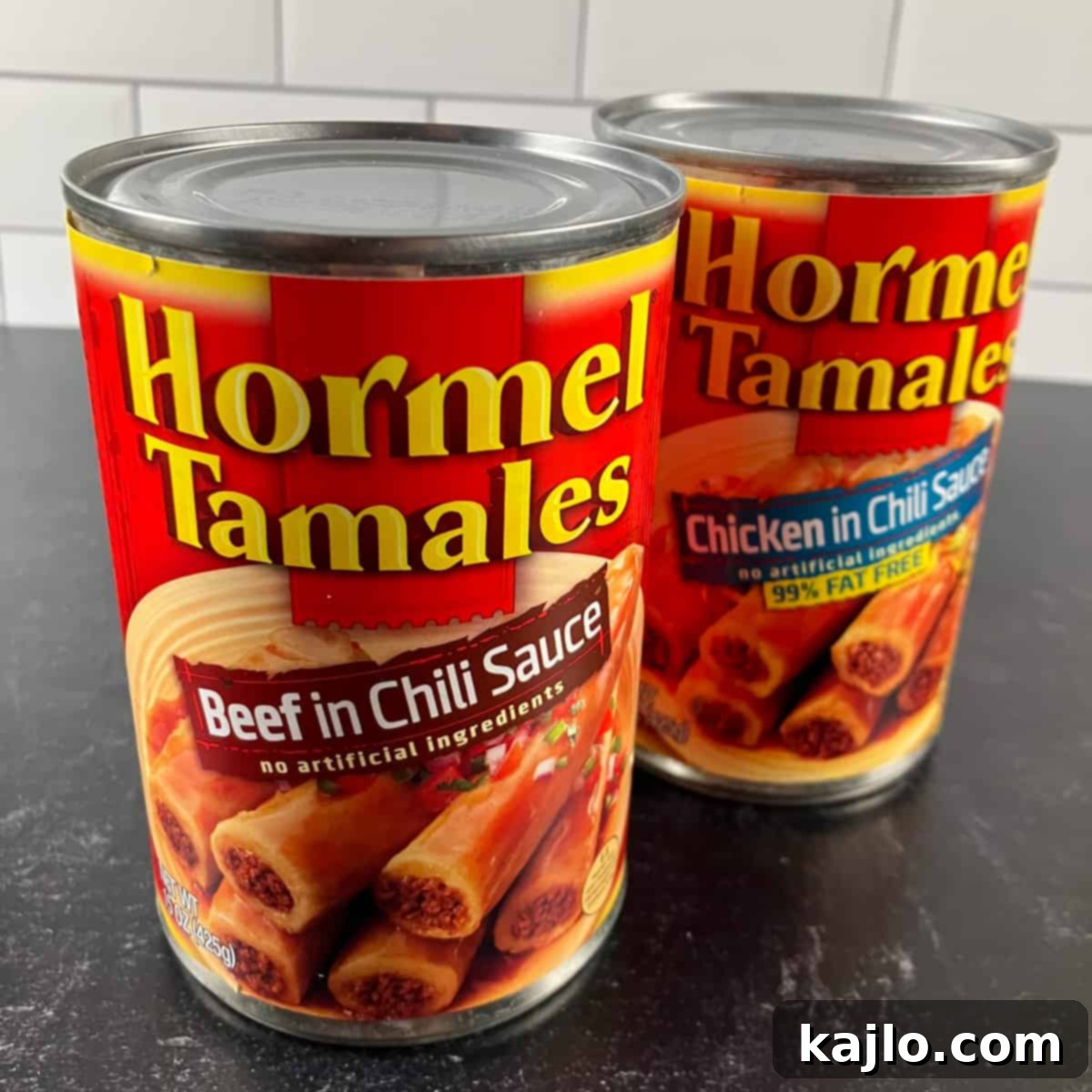
Effortless Cooking: Canned Tamales on the Stovetop
For a quick and easy stovetop preparation, grab a cast iron skillet or any suitable frying pan. Place it over medium heat. Carefully pour the entire contents of the can, including the tamales and their rich chili sauce, into the pan. Arrange the tamales in a single layer, ensuring the waxy paper wrappers remain on during this initial heating phase.
Since canned tamales are already pre-cooked, your goal is simply to heat them thoroughly until the sauce begins to simmer gently. This typically takes only 3-4 minutes. While they are heating, use tongs or a spatula to carefully turn the tamales occasionally, ensuring even heating. Once heated, meticulously remove the paper wrappers with tongs before serving. This method yields warm, savory tamales ready to enjoy in minutes.
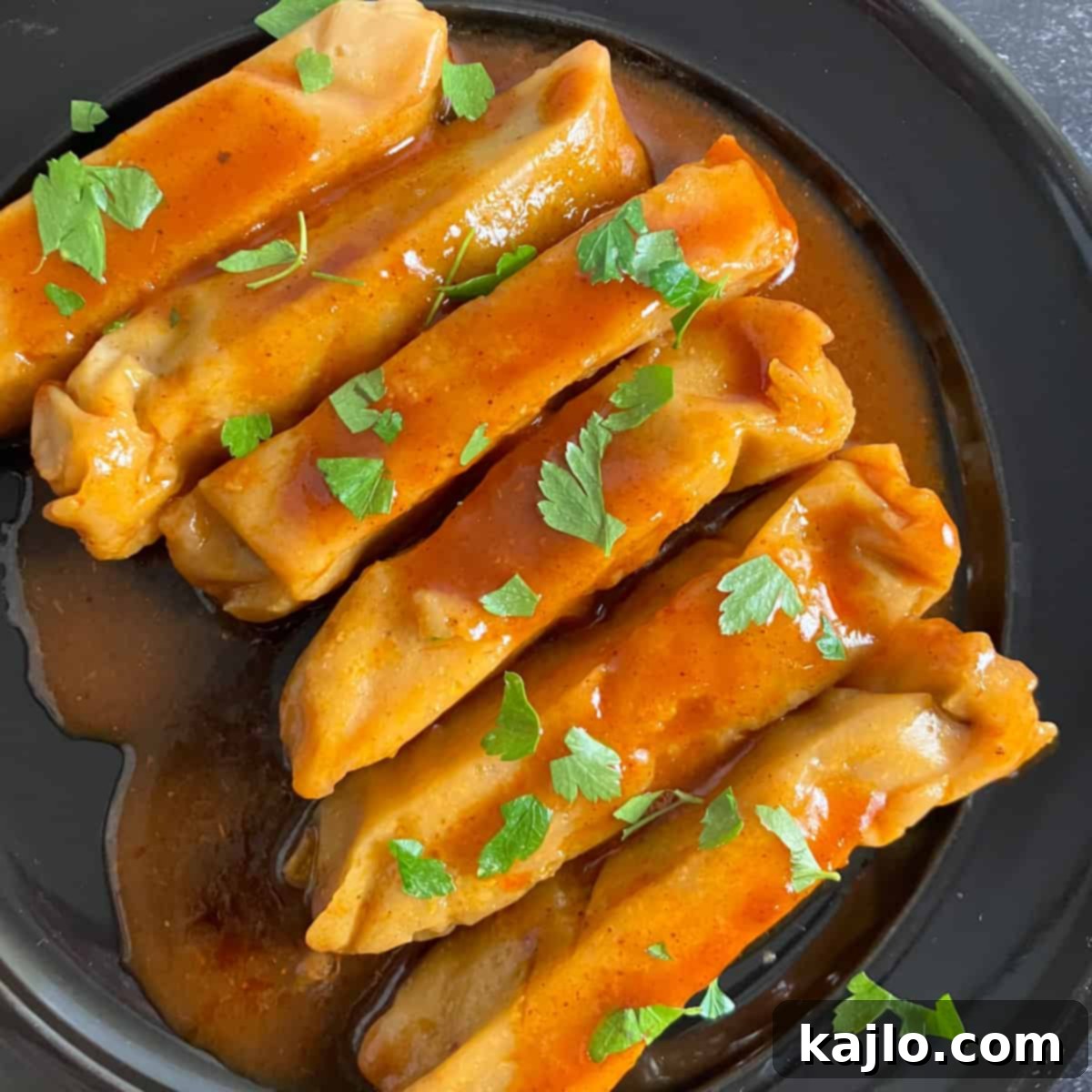
Baking Perfection: How to Prepare Canned Tamales in the Oven
For a delicious baked tamale casserole, often dubbed “CasserOLE” by Hormel, begin by preheating your oven to 350°F (177°C). This method allows for a slightly different texture and the opportunity to add extra ingredients for a more substantial meal.
Next, remove the tamales from the can and carefully unwrap and discard the paper wrappers. Pour the accompanying chili sauce from the can into a glass baking dish. Hormel often suggests enhancing the dish by adding a can of their chili, but this step is entirely optional and the tamales will be delicious on their own or with other additions.

Arrange the unwrapped tamales in a single layer over the sauce in your baking dish. For an extra layer of flavor and indulgence, sprinkle about 3 ounces (85 grams) of shredded cheese over the top. Pepper Jack adds a spicy kick, while cheddar or Monterey Jack offer classic, gooey goodness. Bake the casserole for 25-30 minutes on a rack positioned in the middle of your oven until the cheese is melted and bubbly, and the tamales are thoroughly heated.

Speedy Solution: How to Cook Canned Tamales in the Microwave
When time is of the essence, the microwave offers the quickest way to enjoy your canned tamales. Start by carefully placing the tamales and their sauce in a single layer within a microwave-safe dish. Lightly cover the dish with a paper towel to prevent splattering and help retain moisture. Microwave on high for approximately 3 minutes. After heating, allow the tamales to rest for 1 minute to ensure even heat distribution. Then, carefully remove the paper wrappers before serving. This method is ideal for a fast lunch or a late-night craving.
🌶️ Exploring Tamale Fillings: From Traditional to Canned
The beauty of tamales lies in their incredible versatility when it comes to fillings. They can be stuffed with a wide array of sweet or savory ingredients, varying greatly by region and personal preference. In the U.S., common savory fillings often include beef, pork, chicken, cheese, and various chiles like jalapeños. However, across different parts of the world, tamales boast an even broader spectrum of fillings, such as:
- Tomatoes: Adding a fresh, tangy note.
- Onions: Providing a foundational aromatic flavor.
- Bell Peppers: For sweetness, crunch, and color.
- Potatoes: Offering a starchy, comforting texture.
- Rice: Sometimes incorporated for added bulk and texture.
- Herbs: Fresh cilantro, epazote, or other regional herbs for distinct flavors.
- And even fruits such as pineapples and blackberries, for unique sweet tamale varieties!
While canned tamales usually stick to the more conventional meat fillings, understanding the vast culinary landscape of tamale fillings can inspire you to creatively enhance your canned tamales with fresh toppings or side dishes.

Serving Canned Tamales: Creative Ideas
Wondering how to serve canned tamales to make them a more complete or exciting meal? While they are perfectly enjoyable on their own as a simple snack or light meal, there are many ways to elevate your canned tamale experience. As mentioned, you can easily transform them into a hearty tamale casserole by baking them with extra chili and cheese.
Beyond the casserole, consider these creative serving suggestions:
- Tamale Nachos: Layer heated tamales (unwrapped and crumbled) over tortilla chips, then top with cheese, beans, jalapeños, and a dollop of sour cream or guacamole.
- Deconstructed Tamale Bowl: Serve unwrapped tamales over a bed of cilantro-lime rice, topped with fresh salsa, black beans, corn, and avocado for a vibrant and filling meal.
- Side Dishes for Balance: If you’re making a tamale bake, balance the richness with a refreshing side. A crisp garden salad with a light vinaigrette, steamed green beans, or a vibrant corn salad would complement the tamales beautifully.
- Enhanced Flavor Profile: Add fresh toppings like chopped cilantro, diced red onion, a squeeze of fresh lime juice, or a dollop of crema (Mexican sour cream) to brighten the flavors. A dash of your favorite hot sauce can also add a personalized kick.
For those who enjoy a heartier, carb-rich meal, pairing tamales with a side of fluffy cilantro-lime rice is an excellent option. The fresh flavors of the rice cut through the richness of the tamales, creating a satisfying and well-rounded plate.

🌡️ Storage and Shelf Life of Canned Tamales
How long can tamales stay out of the refrigerator? For food safety, open cans of tamales and any heated tamales should not be left at room temperature for more than 2 hours. After this period, bacterial growth can occur, making the food unsafe to eat.
Once opened or cooked, tamales should be promptly stored. Place cooked tamales or the contents of an opened can in a sealed container and refrigerate them. They will maintain their quality and safety in the fridge for up to 3-4 days. Always ensure the container is airtight to prevent drying out and absorption of other odors.
Unopened cans of tamales are considered non-perishable pantry items, thanks to the canning process which preserves the food. For optimal quality, freshness, and flavor, it’s best to consume the product within the “best by” or “use by” date printed on the can. While technically safe to eat beyond this date if stored in a cool, dry place, there might be a noticeable decline in taste and texture.
Can you freeze canned tamales? It’s generally not recommended to freeze unopened cans of tamales. The canning process already provides a long shelf life, and freezing the sealed can could potentially damage the can or compromise the product’s quality.
However, tamales that have been removed from the can can be frozen. To do so, cool them completely, wrap them individually or in small portions in plastic wrap, then place them in an airtight freezer bag or container. While freezing is possible, be aware that the texture of the masa may become somewhat crumbly or soft after thawing, affecting the overall eating experience. For best results, consume refrigerated tamales within a few days.
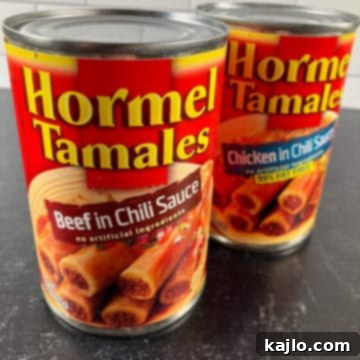
Canned Tamales Recipe (Hormel Tamales in a Can)
By Summer Yule
Whether you prefer Hormel tamales in a can or another brand, this classic comfort food is fast and easy to make!
1 min
4 mins
5 mins
Dinner
American, Mexican
2
190 kcal
Ingredients
- 1 can tamales 15 ounces/425 grams
- 3 ounces shredded cheese 85 grams (optional, for oven directions)
Love this recipe?
Please leave a comment below 😊
Instructions
To Make Canned Tamales on Stove:
- Put a cast iron skillet over medium heat. Pour the sauce and tamales into the pan in a single layer (leave the papers on the tamales).
- Simmer 3-4 minutes, turning the tamales occasionally as they cook. Carefully remove the papers on the tamales with tongs before serving.
To Make Canned Tamales in Oven:
- Preheat the oven to 350°F (177°C).
- Remove the tamales from the can and carefully remove and discard the paper wrappers. Pour the chili sauce from the can into a glass baking dish. Hormel recommends adding a can of their chili to the dish as well, but no big deal if you don’t have one.
- Place the unwrapped tamales in a single layer on top of the sauce in the baking dish. Sprinkle shredded cheese on top. I used Pepper Jack cheese, but cheddar or Monterey Jack would also be great. Bake for 25-30 minutes on a rack in the middle of the oven.
To Make Canned Tamales in Microwave:
- Place the tamales and sauce in a single layer in a microwave-safe dish. Cover loosely with a paper towel, and microwave on high for 3 minutes.
- Let the tamales rest for 1 minute before removing the paper wrappers and serving.
Equipment
- Cast Iron Skillet
- Tongs
- 8×8 Glass Baking Dish
Notes
💭 Expert Tips from Dietitian Summer Yule
This is a level 3 recipe (weight maintenance and active lifestyles). Are canned tamales healthy? Canned tamales are an ultra-processed food and high in sodium. I’d say there are likely many healthier options for you out there.
These little review posts of throwback foods are some of my favorites to write. They tend to be popular, and I enjoy investigating just how “unhealthy” these foods really are. Like other less-than-optimal food choices, it is possible to incorporate canned tamales into an overall healthy meal.
That said, if you are on a low sodium diet, canned tamales are not a good choice. One half of a can of Hormel tamales provides 41% DV for sodium, and many of us finish a whole can by ourselves.
Canned tamales can taste quite salty. Serving the tamales without the chili sauce can help reduce the sodium. However, one of the simplest ways to lower the sodium in your diet is to eat fewer highly processed foods.
Another thing to note is that you’re only getting 4-6 grams of protein per serving of canned tamales. If having them as a meal, you can add more protein by serving them with cheese and beans.
I’d also add some veggie side dishes to help make the meal more filling. The serving of tamales listed on the can is very small in volume. Veggies add color and flavor to your plate, as well as bulk up meals for fewer calories.
Nutrition information is for one serving of 3 Hormel beef tamales.
nutrition info disclaimer
All recipes on this website may or may not be appropriate for you, depending on your medical needs and personal preferences. Consult with a registered dietitian or your physician if you need help determining the dietary pattern that may be best for you.
The nutrition information is an estimate provided as a courtesy. It will differ depending on the specific brands and ingredients that you use. Calorie information on food labels may be inaccurate, so please don’t sweat the numbers too much.
“To taste” means to your preferences, which may have to be visual to follow food safety rules. Please don’t eat undercooked food x
Nutrition
Carbohydrates: 22g
Protein: 6g
Fat: 9g
Saturated Fat: 3.5g
Sodium: 990mg
Fiber: 2g
Vitamin A: 6% DV
Iron: 4% DV
can tamales, canned tamales, canned tamales recipes, canned tamales recipe, hormel canned tamales, hormel tamales, tamales canned, tamales in a can
Shop our cookbook!
Easy Air Fryer Recipes for One
Burning your air fryer recipes?
Here’s how to fix it!
📋 Canned Tamales Nutrition: A Detailed Look
Understanding the nutritional content of your food is crucial for maintaining a balanced diet. Here’s a comparative breakdown of the nutrition information for one serving (approximately 3 tamales) of Hormel tamales with sauce:
| Nutrition Info | Hormel Chicken Tamales | Hormel Beef Tamales |
|---|---|---|
| Calories | 130 | 190 |
| Total Fat | 2g | 9g |
| Saturated Fat | 1g | 3.5g |
| Trans Fat | 0g | 0g |
| Cholesterol | 15mg | 20mg |
| Sodium | 990mg (41% DV) | 990mg (41% DV) |
| Total Carbohydrate | 24g | 22g |
| Fiber | 3g | 2g |
| Total Sugars | 2g | 2g |
| Protein | 4g | 6g |
| Vitamin A | 6% DV | 6% DV |
| Vitamin C | 0% DV | 0% DV |
| Calcium | 4% DV | 0% DV |
| Iron | 2% DV | 4% DV |
As you can see, the canned chicken tamales boast a “99% fat-free” claim, containing significantly less fat and fewer calories compared to their beef counterparts. However, both varieties are notably high in sodium, with a single serving contributing 41% of the daily value. This is an important consideration for individuals monitoring their sodium intake.

Frequently Asked Questions About Canned Tamales
How do you properly eat a tamale?
To enjoy a tamale, the first and most crucial step is to unwrap it! Whether your tamale is traditionally steamed in a corn husk or banana leaf, or comes in a waxy paper wrapper from a can, these coverings are for cooking and presentation, not consumption. Simply peel away the wrapper to reveal the delicious masa and filling inside. Tamales are best eaten with a fork and knife, allowing you to savor each bite of the tender dough and savory center.
Are Hormel tamales gluten-free?
If you follow a gluten-free diet, it’s best to exercise caution with Hormel tamales. The chili powder in their ingredients list often includes “flavoring,” which could potentially contain hidden gluten. Furthermore, during the manufacturing process, canned tamales may experience cross-contact with gluten-containing ingredients or equipment. For strict gluten-free needs, always check the most current product labeling and manufacturer’s website, or opt for certified gluten-free alternatives.
Are canned tamales “good”?
The goodness of canned tamales is largely subjective when it comes to taste. Some people love their distinct flavor and convenience, finding them a comforting and satisfying meal. The best way to determine if canned tamales are “good” for you is to try them and decide for yourself! From a nutritional standpoint, however, canned tamales are often high in sodium and relatively low in protein density for their calorie count. While they can certainly be part of a balanced diet when consumed in moderation, there are generally more nutrient-dense options available for daily meals.
Where can I buy canned tamales?
Canned tamales are widely accessible, making them an easy pantry addition. You can typically find them at most major grocery stores, including large retailers like Super Walmart and Kroger. For convenience, they are also available for purchase online through platforms like Amazon, allowing you to have them delivered directly to your door. Check the canned goods or international foods aisle at your local supermarket.
Are tamales good for diabetics?
For individuals managing diabetes, particularly those following a low-carb diet to control blood sugar, tamales may not be the most suitable choice due to their corn-based masa, which is rich in carbohydrates. However, if you manage your diabetes through a system of carbohydrate exchanges, you might be able to incorporate a small serving of tamales into your diet. Using a Continuous Glucose Monitor (CGM) can provide real-time data on how this food impacts your individual blood sugar levels, helping you determine if it’s a good fit for your specific dietary management plan. Always consult with a healthcare professional or registered dietitian for personalized dietary advice.
👨🏾🍳 More Convenient Canned Food Recipes
If you appreciate the convenience and versatility of canned foods, you’ll love exploring other simple recipes and reviews. Canned ingredients can be transformed into delicious and quick meals with minimal effort. Check out these additional resources for more ideas:
- La Choy Chow Mein: A quick and easy Asian-inspired meal straight from the can.
- Potatoes from a Can: Discover creative ways to use canned potatoes for speedy side dishes and casseroles.
- How to Cook Canned Corned Beef Hash: Learn how to perfectly prepare this classic comfort food.
These recipes highlight how canned foods can be a fantastic base for diverse and satisfying meals, proving that convenience doesn’t have to sacrifice flavor.
Join our community! Subscribe for all of the latest and greatest recipes, and follow me on Facebook, Pinterest, Instagram, and YouTube!
